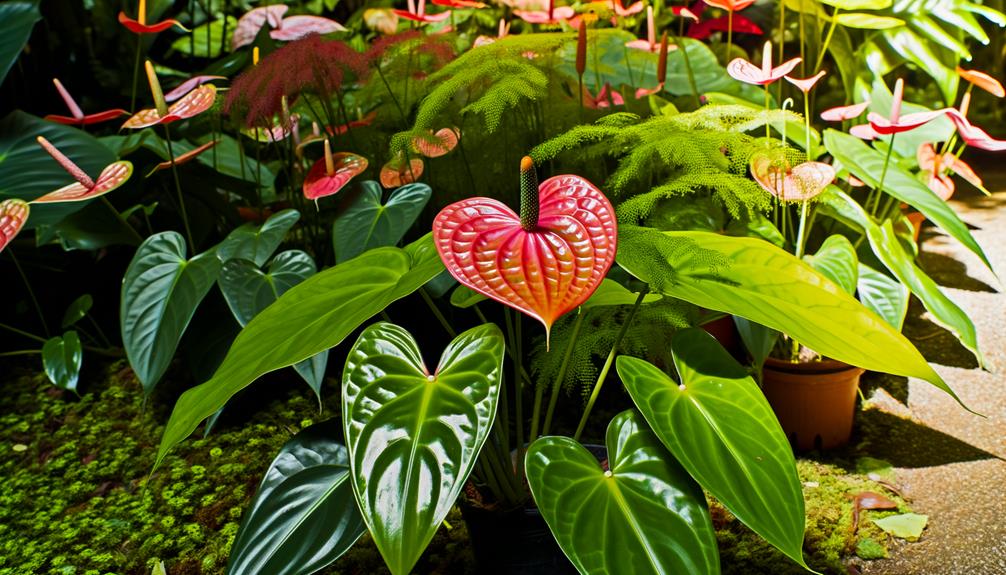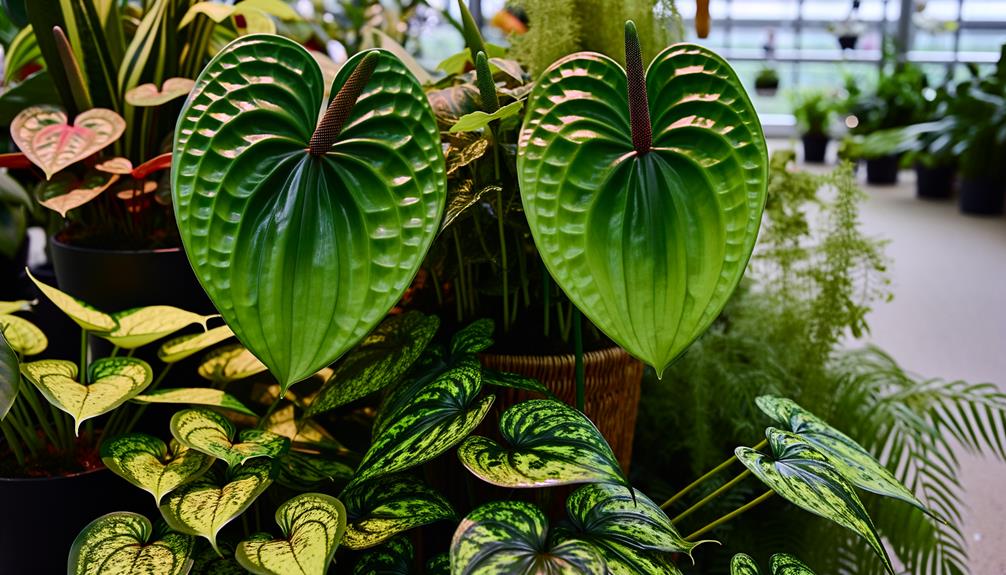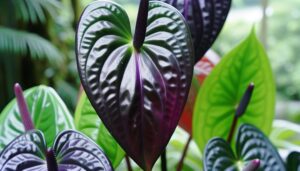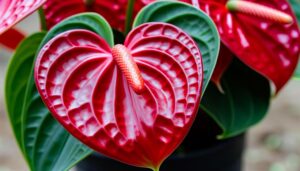Unveiling the Parents of Anthurium Queen of Hearts: A Guide
The Anthurium Queen of Hearts is a stunning hybrid born from the genetic melding of Anthurium Andraeanum and Anthurium Magnificum. Anthurium Andraeanum, native to humid rainforests, contributes vibrant spathes and resilience.
Anthurium Magnificum imparts large, velvety, heart-shaped leaves with pronounced venation. The hybridization involves controlled pollination, ensuring the best traits from both parents are inherited.
For ideal growth, provide indirect light, high humidity, and a well-draining potting mix. Caring for complementary species like Anthurium Clarinervium and Crystallinum can enhance your collection.
Interested in the intricate interplay of hereditary traits making this hybrid so unique? Keep going for more insights.

Key Takeaways
- Anthurium Queen of Hearts is a hybrid of Anthurium Andraeanum and Anthurium Magnificum.
- The hybridization process involves controlled pollination and genetic combination of the parent plants.
- Unique traits include velvety leaf texture, heart-shaped leaves, and prominent venation.
- Anthurium Andraeanum contributes to the plant’s adaptability in humid, tropical environments.
- Anthurium Magnificum is known for its large, velvety leaves, enhancing the hybrid’s aesthetic appeal.
Origins of Anthurium Queen of Hearts

The Anthurium Queen of Hearts originated from the hybridization of two distinct species, carefully selected for their unique foliage and vibrant colors.
You’ll find that this hybridization process involves controlled pollination, ensuring the desired traits are inherited.
It’s a meticulous journey where botanists aim to combine the vivid spathes and robust leaves from each parent plant.
The result is a striking plant with heart-shaped leaves and a vibrant red spathe that captivates anyone seeking botanical beauty.
The precise genetic combinations give rise to a plant that’s not only visually appealing but also resilient.
You can appreciate how this careful selection and hybridization process embodies a quest for perfection, offering a sense of freedom through the plant’s natural elegance and robust characteristics.
Parent Plant One: Anthurium Andraeanum
You’ll find Anthurium andraeanum thriving in the humid, tropical rainforests of Colombia and Ecuador. Its distinctive spathes, often mistaken for flowers, exhibit vibrant reds and pinks, essential for attracting pollinators.
For best growth, you must maintain high humidity, indirect light, and well-draining soil.
Native Habitat Origins
Originating from the lush rainforests of Colombia and Ecuador, Anthurium andraeanum thrives in warm, humid environments with filtered sunlight. You’ll find it clinging to trees as an epiphyte or nestled in the forest floor’s rich organic matter.
This plant’s native habitat offers unique conditions that contribute to its growth:
- Humidity: High humidity levels, often exceeding 80%, are essential for its foliar and root health.
- Temperature: Consistent temperatures between 70-90°F (21-32°C) promote ideal development.
- Light: Indirect, dappled sunlight mimics the rainforest canopy, preventing leaf scorch and enhancing photosynthesis.
Understanding these environmental factors allows you to replicate similar conditions at home, ensuring your Anthurium andraeanum flourishes just as it would in its natural habitat.
Distinctive Flower Characteristics
Admire the Anthurium andraeanum’s distinctive spathes, which exhibit a glossy, waxy texture and vibrant shades of red, pink, or white, central to its identification and allure.
The spathe, a modified leaf, encases the spadix, a cylindrical structure densely packed with numerous tiny flowers.
These intricate features not only enhance its aesthetic appeal but also play an essential role in its reproductive process.
| Feature | Description | Function |
|---|---|---|
| Spathe | Glossy, waxy, vibrant red, pink, white | Attracts pollinators |
| Spadix | Cylindrical, densely flowered | Flowering structure |
| Leaf Texture | Glossy and leathery | Enhances photosynthesis |
Growth and Care
Understanding the mesmerizing flower characteristics of the Anthurium andraeanum sets the stage for mastering its growth and care requirements. You’ll need to focus on specific conditions to guarantee your plant thrives.
- Lighting: Provide bright, indirect sunlight. Direct sun can scorch the leaves, while too little light results in poor flowering.
- Watering: Maintain consistently moist soil without waterlogging. Use a well-draining potting mix, and water when the top inch of soil is dry.
- Humidity: Anthurium andraeanum thrives in high humidity. Aim for 60-80% humidity, using a humidifier or pebble tray if necessary.
Parent Plant Two: Anthurium Magnificum

Anthurium Magnificum, known for its large, velvety leaves and prominent veins, plays an important role in the genetic makeup of the Anthurium Queen of Hearts.
You’ll find that Magnificum contributes significantly to the plant’s structural integrity and aesthetic appeal. Its sturdy leaf texture, combined with pronounced venation, provides both strength and visual allure.
Concerning growth habits, Magnificum’s ability to adapt to various humidity levels and light conditions enhances the resilience of its hybrid offspring. Additionally, Magnificum’s genetic influence ensures a strong root system, crucial for nutrient absorption and overall plant health.
Unique Features Inherited
The Anthurium Queen of Hearts inherits its alluring velvety leaf texture and prominent venation directly from its parent plants.
You’ll notice several unique features that make this hybrid stand out:
- Leaf Morphology: The heart-shaped leaves exhibit a deep, rich green coloration with a velvety finish, a characteristic derived from its Anthurium parentage.
- Venation Pattern: Prominent, white venation provides a striking contrast against the dark foliage, enhancing the visual appeal.
- Robust Growth Habit: This hybrid demonstrates vigorous growth and resilience, making it well-suited for diverse environments.
Each of these features contributes to the Anthurium Queen of Hearts’ exceptional beauty and adaptability. By understanding these inherited traits, you can better appreciate the intricate botanical lineage at play.
Genetic Contributions

You’ll find that understanding the genetic contributions of the Anthurium Queen of Hearts requires examining its parental lineage.
By analyzing inherited traits, you can trace specific phenotypic characteristics back to each parent.
The hybridization process itself plays an essential role in determining the plant’s unique attributes.
Parental Lineage Insights
Genetic contributions to the Anthurium Queen of Hearts reveal a complex interplay of hereditary traits from both parent plants, highlighting specific phenotypic expressions. You can trace the lineage to understand how certain characteristics were inherited.
Key insights include:
- Dominant and Recessive Alleles: These determine the vibrant coloration and heart-shaped leaves that define the Anthurium Queen of Hearts.
- Hybrid Vigor: Crossbreeding has produced a robust plant with enhanced growth rates and disease resistance.
- Phenotypic Variations: The parent plants contribute to unique variations in leaf texture and size, creating a distinctive appearance.
Understanding these genetic contributions allows you to appreciate the botanical artistry behind the Anthurium Queen of Hearts, celebrating its rich heritage and unique traits.
Inherited Traits Analysis
Analyzing the inherited traits of the Anthurium Queen of Hearts reveals the influence of specific genetic markers that govern leaf morphology and color vibrancy.
You’ll notice that the parent plants contribute genes responsible for the heart-shaped leaves and their striking hues.
These traits are controlled by alleles located at particular loci, influencing phenotypic expression.
For instance, dominant alleles might dictate the deep green coloration, while recessive ones might modify leaf texture.
The interplay between these genetic contributions results in the unique appearance of the Queen of Hearts.
Additionally, chlorophyll concentration and anthocyanin presence are key factors, regulated by inherited sequences that determine pigmentation patterns.
Understanding these genetic parameters helps you appreciate the botanical elegance of this Anthurium variety.
Hybridization Process Explained
Delving into the hybridization process, understanding how specific genetic contributions from parent plants combine is essential to create the Anthurium Queen of Hearts.
You need to grasp the following crucial aspects of genetic interplay:
- Gene Dominance: Determine which genes from each parent plant exhibit dominance. Dominant genes will express more prominently in the hybrid.
- Recessive Traits: Identify recessive traits that may not be immediately visible but can emerge in future generations through selective breeding.
- Genetic Variability: Assess the genetic diversity between parent plants to ensure a robust hybrid with desirable traits, such as enhanced color and leaf shape.
Cultivation Insights
To successfully cultivate Anthurium Queen of Hearts, make sure that the plant receives indirect light and maintains a humidity level of around 60-80%. Aim for a temperature range between 65-80°F.
Use a well-draining potting mix, such as one combining orchid bark, perlite, and peat moss, to mimic its natural tropical environment. Water the plant when the top inch of the soil feels dry, ensuring it never sits in waterlogged conditions.
Fertilize monthly with a balanced, water-soluble fertilizer diluted to half strength during the growing season.
Regularly monitor for signs of pests like spider mites and aphids, and address them promptly. Prune dead or yellowing leaves to maintain vigor and promote healthy growth.
Enhancing Your Collection

After mastering the cultivation of Anthurium Queen of Hearts, explore expanding your collection with complementary species that share similar care requirements.
This strategic enhancement not only diversifies your collection but also fosters a harmonious growing environment.
Here are three species to contemplate:
- Anthurium Clarinervium: Known for its striking, velvety leaves with pronounced white veins, it thrives in similar humidity and light conditions as the Queen of Hearts.
- Anthurium Crystallinum: This species features large, heart-shaped leaves with a crystalline appearance, requiring comparable care regarding soil and watering.
- Anthurium Magnificum: Recognized for its robust, dark-green foliage and prominent venation, it complements your collection aesthetically and horticulturally.
Incorporate these species to create a visually stunning and botanically coherent collection.
Conclusion
In your quest to cultivate the Anthurium Queen of Hearts, you’ll find that understanding its lineage is key.
The marriage of Anthurium Andraeanum and Anthurium Magnificum has produced a plant that’s both resilient and stunning.
By recognizing the genetic gifts each parent bestows, you’re better equipped to nurture its unique features.
So, as you enhance your collection, remember: the heart of your garden will beat with the rhythm of informed care and scientific insight.






